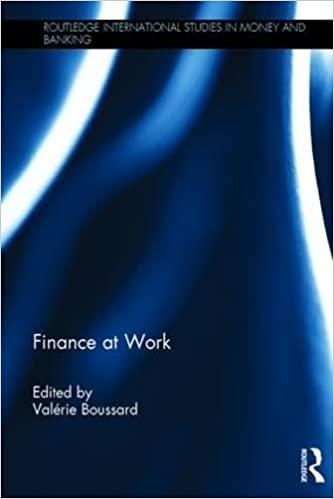Question
1. If we are able to eliminate all of the unsystematic or diversifiable risk in a portfolio then, what is the result? a. a risk-free
1. If we are able to eliminate all of the unsystematic or diversifiable risk in a portfolio then, what is the result? a. a risk-free portfolio b. a portfolio that has an expected return of zero c. a portfolio that contains only systematic risk
2. A portfolio consists 20% of a risk-free asset and 80% of a stock. The risk-free return is 4%. The stock has an expected return of 15% and a standard deviation of 30%. Whats the expected return of the portfolio? a. 9.5% b. 15.0% c. 12.8%
d. 2%
3. The risk-free rate is 5% and the expected return on the market portfolio is 13%. A stock has a beta of 1.5, what is its expected return?
a. 12% b. 19.5% c.
17%
4. For what value of the correlation coefficient for the returns of a pair of stocks will the benefits of diversification the largest?
a. 1.0 b. -1.0 c. 0.0 d. 0.5
5. Which of the following is an example of systematic risk? a. IBM posts lower than expected earnings. b. The overall stock market becomes more risky due to super fasting trading algorithms. c. Intel announces record earnings.
6. According to the CAPM (capital asset pricing model), the security market line is a straight line. The intercept of this line should be equal to a. zero b. the expected risk premium on the market portfolio c. the expected return on the market portfolio d. the risk-free rate
7. A portfolio has 40% invested in Asset 1, 50% invested in Asset 2 and 10% invested in Asset 3. Asset 1 has a beta of 1.2, Asset 2 has a beta of 0.8 and Asset 3 has a beta of 1.8, whats the beta of the portfolio?
a. 0.80 b. 1.06 c. 1.27
8. Suppose you can borrow and lend at the risk free-rate of 3%. Which of the following four risky portfolios has the best return relative to risk. (Hint: Calculate Sharpe Ratios the ratio of risk premium to standard deviation for each portfolio)
a. portfolio with a standard deviation of 15% and an expected return of 12% b. portfolio with a standard deviation of 12% and an expected return of 9% c. portfolio with a standard deviation of 25% and an expected return of 18% d. portfolio with a standard deviation of 19% and an expected return of 15%
9. Which statements are TRUE regarding risk and return?
Statement I: Diversification is the process of removing systematic risk from a portfolio. Statement II: In general, the greater the risk, the greater the return required by an investor. Statement III: Investors should focus on real returns if they are concerned about the purchasing power of their wealth.
a. Statements II and III only b. Statement I only c. Statements I and III only d. Statements I and II only
10. The beta of the risk-free asset is: a. 1.0 b. 0.5 c. 0.0 d. -1.0
Step by Step Solution
There are 3 Steps involved in it
Step: 1

Get Instant Access to Expert-Tailored Solutions
See step-by-step solutions with expert insights and AI powered tools for academic success
Step: 2

Step: 3

Ace Your Homework with AI
Get the answers you need in no time with our AI-driven, step-by-step assistance
Get Started


